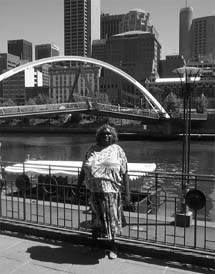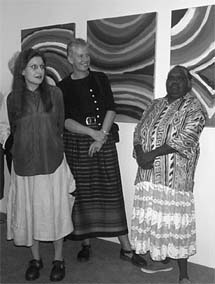Peggy Napangardi Jones
Alison Alder works with Peggy at the
Pink Palace and she tells the story ...
From the moment Peggy Napangardi Jones started on her
first big painting, there was no stopping her - a well spring of visual
imagery had been tapped and the images flowed freely through the brush
and on to the canvas.
Soakages, wells, birds, animals, bush tucker - all of them wild with
colour and beautiful in the simplicity of their composition. Peggy's
paintings are associated with her country and her dreaming and are incredibly
joyous. Her paintings seem to strike a chord with most people who view
them, so much so that her first solo show held in Melbourne last month
was a sell-out.
Even people with no knowledge of this country find something in Peggy's
paintings to make them smile. One woman, a Melbourne barrister, who
has a degenerative disease which will make her blind in the next three
years bought two of Peggy's paintings because she wants to remember
the bright colours Peggy uses when she can no longer see. Collectors
were playing tug-of-war to purchase paintings before the opening having
seen work that is different, completely fresh and unrestrained.
The art world in Melbourne is a long way from Tennant Creek but Peggy's
paintings somehow bridge the gap. Peggy was a wonderful ambassador for
Tennant Creek at the opening, wearing clothes as bright as her paintings,
and speaking after the opening speech by Judith Ryan, Curator of Aboriginal
Art at the National Gallery of Victoria. Peggy spoke of the importance
of Julalikari Council's Arts and Crafts workshop (the Pink Palace) and
the good fortune she had to have access to the skills and support offered
by staff at Julalikari and Batchelor College.
"It was where I learnt what I want to do," she told the assembled
guests.
There is a lot of pressure on Aboriginal artists to produce work to
fit in with the white tourist ideal of what constitutes Central Australian
Aboriginal art (ie dots, ochres, snakes).
However, the first painting Peggy did on canvas was a big one, stretched
onto a silkscreen frame, of a soakage site. Prior to this painting Peggy
had restricted her more interesting work to paper and silk.
This painting was a real breakthrough, she had broken the dot barrier,
a wonderful painting had been produced and it was accepted into the
National Aboriginal and Torres Strait Islander Art Award. It was subsequently
purchased by the judge, James Mollison, former Director of the National
Gallery of Australia and National Gallery of Victoria.
Julalikari Council has been supporting the Arts and Crafts in Tennant
Creek since 1994, in the form of the CDEP Women's Arts and Crafts program
currently operating out of the Pink Palace in Mulga Camp. Over the past
three or so years the Pink Palace has been gaining increased recognition
for its initiatives in training and work opportunities offered to the
participants.
Arts and crafts are a vehicle for learning new skills, not just in art
production, but in reading and writing, administration skills, public
speaking, tourism, cultural maintenance and the workshop also acts as
a meeting place. Many of the women who work at the Pink Palace are not
'artists' per se but usually are able to 'find their thing' in some
art form or other or in some other skill associated with the running
of the centre.
The success of the current Peggy Napangardi Jones exhibition demonstrates
the importance of community development, of support for the arts and
the benefits, not only to an artist, but to a whole community. But most
of all it is testimony to the hard work and vision of Peggy Napangardi
Jones.
Peggy Napangardi Jones had an exhibition
of her paintings in Melbourne recently.
The show was highly acclaimed by the critics
and her works were all sold after one day.


Peggy beside the Yarra.

Judith Ryan fromm
the National Gallery of Victoria, Alison Alder and Peggy Jones at the
opening.